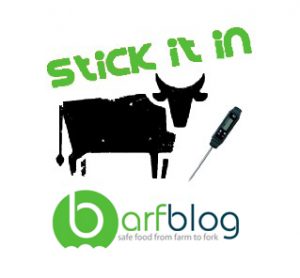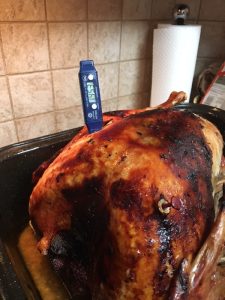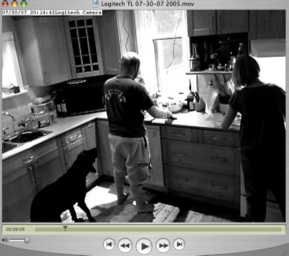This paper came out in Feb. but was lost in the Covid haze.
 Observation is always better than self-reported survey BS (I cooked the turkey below, in Brisbane, and it went back in the oven)
Observation is always better than self-reported survey BS (I cooked the turkey below, in Brisbane, and it went back in the oven)
Chapman learned well. Abstract below.
The purpose of this study was to test the effectiveness of an intervention for consumer thermometer use by using a randomized experimental design and direct observation of meal preparation.
The study was conducted in test kitchen facilities in two locations in North Carolina (one urban and one rural). Cameras recorded participants’ actions at various locations throughout the kitchen and recorded the meal preparation from beginning to end. Before preparing the meal, a randomized treatment group watched a 3-min U.S. Department of Agriculture (USDA) food safety video “The Importance of Cooking to a Safe Internal Temperature and How to Use a Food Thermometer.”
Participants in the control and treatment groups were observed while cooking turkey burgers and preparing a salad to determine whether a thermometer was used to check the doneness of the turkey patties. Following meal preparation, all participants responded to a post-observation interview about food handling behaviors. Treatment group participants were also asked about the intervention.
 A total of 383 people participated in the study (201 in the control group and 182 in the treatment group). Participants who viewed the video were twice as likely to use a thermometer to check the doneness of the turkey patties compared with the participants who were not exposed to the video (75 versus 34%) and twice as likely to place the thermometer in the correct location (52 versus 23%). Sixty-seven percent of participants who watched the video reported that it influenced their behavior in the kitchen.
A total of 383 people participated in the study (201 in the control group and 182 in the treatment group). Participants who viewed the video were twice as likely to use a thermometer to check the doneness of the turkey patties compared with the participants who were not exposed to the video (75 versus 34%) and twice as likely to place the thermometer in the correct location (52 versus 23%). Sixty-seven percent of participants who watched the video reported that it influenced their behavior in the kitchen.
This study demonstrates the importance of timing and framing of a behavioral intervention for thermometer use and highlights considerations for the development of additional messages (e.g., proper insertion).
An observational study of thermometer use by consumers when preparing ground turkey patties
Minh Duong; Ellen Thomas Shumaker; Sheryl C Cates; Lisa Shelley; Lydia Goodson; Christopher Bernstein; Aaron Lavallee; Margaret Kirchner; Rebecca Goulter; Lee-Ann Jaykus; Benjamin Chapman
Journal of Food Protection
https://doi.org/10.4315/JFP-19-594
https://meridian.allenpress.com/jfp/article-abstract/83/7/1167/426199











